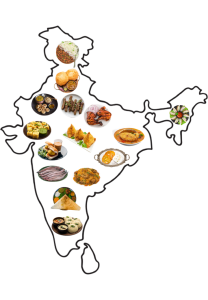
India’s food is a vibrant tapestry, woven from threads of history, migration, and cultural exchange. It is a cuisine that defies rigid boundaries, embracing influences from across the globe while remaining distinctly local. Yet, food in India is also a site of contestation, entangled with politics, caste, and, increasingly, the divisive ideology of Hindutva. From debates over beef to the stigmatization of certain diets, food has been weaponized to deepen social fractures. However, the very history of Indian cuisine—its syncretic, global, and adaptive nature—offers a potential antidote to the exclusionary narratives of Hindutva violence. By celebrating the shared, hybrid origins of India’s culinary traditions, we can foster a counter-narrative of unity and inclusivity, one that transcends caste, religion, and politics.
The Global Roots of Indian Food
Indian cuisine is often celebrated as ancient and timeless, yet many of its staples are relatively recent arrivals, brought through trade, conquest, and colonialism. Potatoes, tomatoes, and chilies—now indispensable to Indian cooking—originated in South America and arrived in India via Portuguese traders in the 16th century. The humble potato, a cornerstone of dishes like aloo paratha and masala dosa, and the fiery chili, which defines much of India’s spice profile, are not “native” but adopted and transformed. Similarly, the tomato, a key ingredient in curries and chutneys, is a colonial import that India made its own.
This culinary exchange extends beyond South America. The Portuguese introduced bread, giving rise to pav (as in pav bhaji), while the British left behind a legacy of tea-drinking and Anglicized dishes like mulligatawny soup. Samosas, often considered quintessentially Indian, trace their origins to Central Asian stuffed pastries brought by Mughal rulers. Even the beloved vada, a South Indian staple, reflects a history of adaptation, with its fried, doughnut-like form echoing culinary techniques from across the Indian Ocean.
Parallels with Mexican cuisine are striking. Both India and Mexico absorbed New World ingredients—potatoes, tomatoes, and chilies—into their culinary lexicons, creating dishes that feel ancient but are historically recent. The Mexican mole, with its complex blend of spices and chocolate, mirrors the layered gravies of Indian curries, while the tortilla shares a kinship with the Indian roti. These shared histories underscore a truth: no cuisine is “pure.” Indian food, like its Mexican counterpart, is a product of global exchange, a testament to humanity’s ability to adapt and innovate.
Food as a Site of Division
Despite this rich history of fusion, food in India has become a flashpoint for division, particularly under the influence of Hindutva ideology. Hindutva, with its vision of a homogenous Hindu nation, often weaponizes food to enforce caste hierarchies and marginalize religious minorities. The cow, revered as sacred by many Hindus, has been at the center of violent campaigns against Muslims and Dalits, who are targeted for consuming or handling beef. Lynchings and mob violence over suspected cow slaughter have spiked in recent years, with data from Human Rights Watch noting over 50 such incidents between 2015 and 2019 alone.
Caste also plays a pernicious role. Upper-caste vegetarianism is often framed as morally superior, stigmatizing communities that consume meat, particularly beef or pork. Dalit food practices, such as eating pork or scavenging for food, are denigrated, reinforcing caste oppression. Even vegetarian dishes are not immune to caste politics—upper-caste norms often dictate “pure” ingredients or preparation methods, marginalizing lower-caste culinary traditions.
Hindutva’s narrative of cultural purity ignores the hybridity of Indian food. It seeks to impose a monolithic “Hindu” diet, erasing the diversity of regional, caste, and religious food practices. This erasure fuels violence, as food becomes a marker of “us” versus “them.” Yet, the history of Indian cuisine tells a different story—one of connection, not division.
The Food Miracle: A Path to Unity
The syncretic history of Indian food offers a powerful counter-narrative to Hindutva’s exclusionary ideology. By embracing the “food miracle”—the story of how India absorbed, adapted, and celebrated global influences—we can challenge the notion of a singular, “pure” cultural identity. This narrative can foster unity in several ways.
First, food’s shared history can bridge divides. The potato in an aloo tikki or the chili in a vindaloo is a reminder that India’s culinary identity is global, not insular. Highlighting these connections—such as the parallels with Mexican cuisine—can humanize “the other” and undermine xenophobic narratives. Community initiatives, like food festivals celebrating India’s colonial and global culinary heritage, could showcase dishes like pav bhaji, samosas, and dosas as products of cultural exchange, encouraging dialogue across communities.
Second, food can challenge caste hierarchies. Many Dalit and lower-caste communities have rich culinary traditions that deserve celebration, not stigmatization. Efforts like Dalit food festivals, which have gained traction in cities like Delhi and Mumbai, highlight dishes like pork curry or beef sukka, reclaiming pride in marginalized cuisines. Mainstream platforms—chefs, restaurants, and food media—can amplify these traditions, normalizing diverse food practices and dismantling caste-based prejudices.
Third, food can be a site of interfaith unity. India’s culinary landscape is shaped by Hindu, Muslim, Christian, Sikh, and other traditions. Biryani, a dish associated with Muslim communities, is beloved across India, while Christian communities in Kerala and Goa contribute dishes like appam and sorpotel. By celebrating these shared culinary spaces, we can counter narratives that pit communities against each other. Interfaith food events, like communal iftars or langars, already model this inclusivity and could be scaled up to promote dialogue.
Practical Steps Forward
To harness the food miracle as an antidote to Hindutva violence, concerted efforts are needed:
1. Education and Awareness: Schools and media should teach the global history of Indian food, emphasizing its hybridity. Documentaries, books, and social media campaigns can highlight how dishes like curry or vada emerged from cultural exchange, challenging notions of purity.
2. Community Engagement: Grassroots initiatives, such as food walks or cooking workshops, can bring diverse groups together to cook and eat, fostering empathy. For example, a workshop pairing Mexican and Indian chefs to explore their shared ingredients could spark conversations about global connections.
3. Policy Support: Governments and NGOs can support inclusive food spaces, like markets or festivals, that celebrate regional and marginalized cuisines. Policies ensuring food security for all communities, regardless of caste or religion, can reduce the economic vulnerabilities that fuel food-related conflicts.
4. Amplifying Marginalized Voices: Chefs, food writers, and influencers should platform Dalit, Adivasi, and minority food traditions. Collaborations with activists and historians can contextualize these cuisines within India’s broader culinary story.
Conclusion
India’s food is a miracle of adaptation and resilience, a testament to the country’s ability to embrace the world while forging something uniquely its own. In a time when Hindutva violence seeks to divide, this culinary history offers a path to healing. By celebrating the global, syncretic roots of Indian food—its potatoes from South America, its pav from Portugal, its samosas from Central Asia—we can challenge the politics of exclusion and caste. Food, in its universality, has the power to remind us of our shared humanity. The question is whether we can wield this miracle to nourish not just our bodies, but our fractured society.

